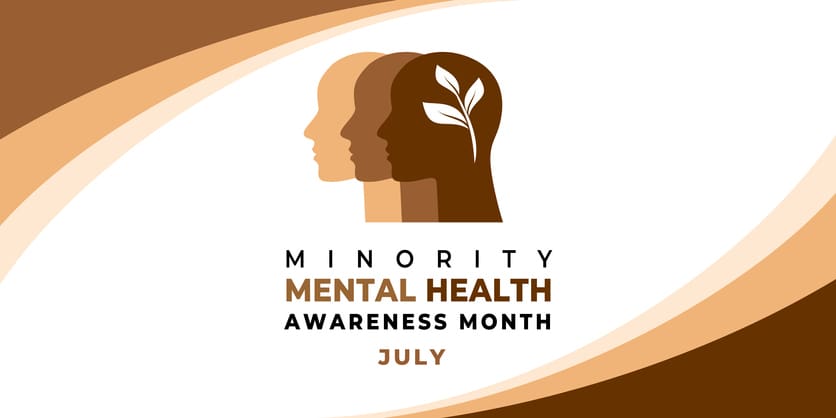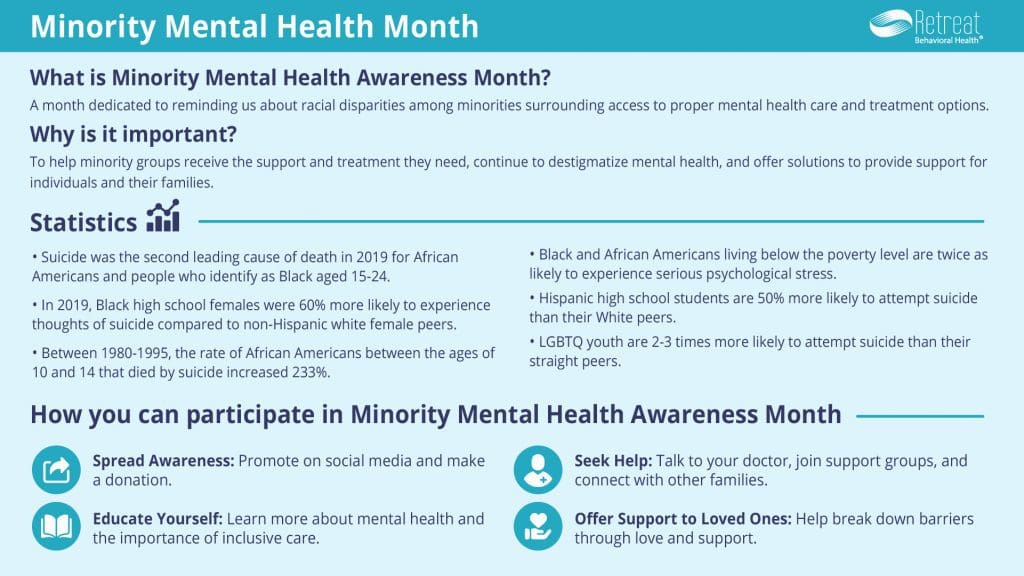Here’s What You Should Know About Minority Mental Health Month and How You Can Get Involved
Society is becoming more interconnected every year making it easier than ever to initiate critical conversations and advocate for important policies during Minority Mental Health Month. Mental health has become an important topic in modern-day society and we are making real strides towards destigmatizing the topic and creating change as more people understand the process of treating and supporting people with mental health conditions, and their families.
Minority Mental Health Awareness Month is particularly important because it addresses mental health disparities by race, continues to help destigmatize mental health, and provides innovative solutions for future generations. Let’s take a look at the history of this campaign.
The Movement Behind Mental Health And Minorities
The full name of the campaign is “Bebe Moore Campbell National Minority Mental Health Awareness Month,” named after best-selling author and mental health advocate Bebe Moore Campbell. Campbell began working on the concept of minority mental health awareness in 2005, two years after releasing her first children’s book entitled Sometimes My Mommy Gets Angry.
She and lifelong friend Linda Wharton-Boyd began spreading their message by holding news conferences in Washington, D.C., hosting book signings, and speaking in churches.
Unfortunately, Bebe Moore Campbell lost her battle to cancer in November of 2006, but her legacy continued. Supporters of this movement pressed on to eventually obtain the support of U.S. representatives, who would co-sign legislation in 2008, making Minority Mental Health Awareness Month official.
The same resilience of Bebe Moore Campbell’s legacy continues today, but to keep this momentum going we must understand the connection between mental health and minorities.
What’s The Connection Between Mental Health And Minorities?
Mental health discussions are necessary for all of us, but in order to help minority groups receive the support and treatment they need, we must understand that minorities have barriers that other racial and ethnic communities may not experience.
Employment-related issues include lack of health insurance and coverage or an inability to take time off to get treatment. Social issues include language barriers or lack of equipped professionals in a region or community.
And then, there are emotional issues, which are harder to both identify and address. Asking for help is hard for most people. Due to cultural views and ancestral backgrounds, this can be especially true for minority communities. Minority individuals may be too scared or ashamed to reach out and ask for help.
The Statistics
According to the 2019 U.S. Census, almost 42% of the U.S. population are people of color. And in 2018, an estimated 4.5% of the U.S. population identifies as LGBTQ+.
Based on the results of mental health screenings at mhanational.org, LGBTQI+ and minority groups were more likely to screen positive or at risk for anxiety, depression, alcohol or substance use, and more.
We must raise awareness in our communities to help bring a positive change to these statistics.
How Can I Get Involved?
First, encourage others to seek treatment. Breaking down barriers through love and support from loved ones is probably the most powerful way to create change both within and outside your community.
You can also join support groups or online forums. Social media is a great place to connect with others and share your story or experience.
Lastly, any size donation helps, along with sharing that you donated. It may inspire others to do the same!
Please contact us with questions you may have about receiving comprehensive mental health care.
Minority Mental Health Awareness Month was created to help include minority groups in the conversation, so everyone has the same opportunity to receive the help and support they deserve.





